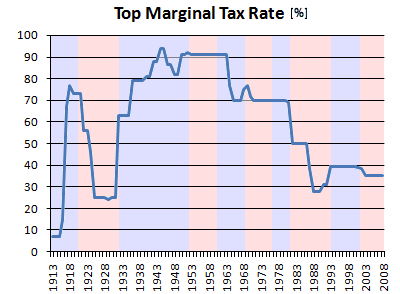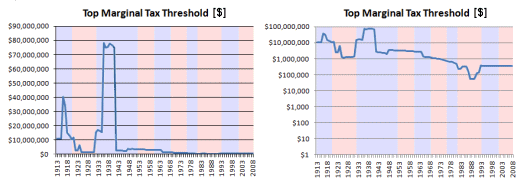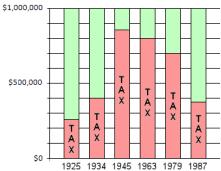
note: inflation adjusted dollars

note: inflation adjusted dollars
The income tax was formalized as the major vehicle for public finance in 1913, and rates were escalated as we prepared for entering the war in Europe. After Wilson, Harding and Coolidge gradually lowered the Income Tax assessments until the beginning of the Great Depression and the election of F.D.R. Under FDR, the Income Taxes were raised dramatically during the Depression and World War II, particularly on the wealthy. The Tax Brackets for 1925, 1934, and 1945 show the magnitude of the increases [adjusted to 2008 dollars using the cpi-u]:

For example, a wealthy person whose yearly adjusted gross income was $1,000,000 [in 2008 dollars] paid taxes of $250,000 in 1925, $400,000 in 1934, and $850,000 in 1945! We often venerate our Soldiers and Rosie the Riveter for their Herculean efforts during those years, but we also owe Reggie the Rich Guy some heartfelt gratitude for financing the enterprise.
I’ve always wondered why F.D.R.’s efforts during the massive crises in the first half of the 20th Century produced so much persisting venom. After all, the guy was saving America and most of Western Civilization as we know it. Seems like we could cut him some slack. But looking at the figures, World War II wasn’t the end of it. Here are the Tax Brackets for 1963, 1979, and 1987 [adjusted to 2008 dollars using the cpi-u]:

 In 1963, some 20 years after the end of the war, our hypothetical rich guy making $1,000,000 a year [adjusted gross income in 2008 dollars] was still paying $800,000/year in taxes. Johnson lowered the taxes brackets in 1964, but he continued to pay $700,000/year in 1979. When Reagan was elected, he instituted two deep tax cuts that radically changed things for Mr. Hypothetical. By 1987, he was paying $385,000/year on his $1,000,000 [adjusted gross income in 2008 dollars]. I realize this is hard to follow on the graphs because of the scale differences, so the graph on the right summarizes the changes in taxation for our hypothetical rich guy over the years.
In 1963, some 20 years after the end of the war, our hypothetical rich guy making $1,000,000 a year [adjusted gross income in 2008 dollars] was still paying $800,000/year in taxes. Johnson lowered the taxes brackets in 1964, but he continued to pay $700,000/year in 1979. When Reagan was elected, he instituted two deep tax cuts that radically changed things for Mr. Hypothetical. By 1987, he was paying $385,000/year on his $1,000,000 [adjusted gross income in 2008 dollars]. I realize this is hard to follow on the graphs because of the scale differences, so the graph on the right summarizes the changes in taxation for our hypothetical rich guy over the years.
I started poring over these Tax Bracket tables because it makes me mad when the Republican Conservatives start in with their screaming about "tax and spend" Democrats. I’d figured out that they "spend" part was malarkey. Since World War II, the Republicans have been the big spenders – that part is unquestioned [see war on Talking Points…] , but I was a dunce about taxes. Maybe everyone else already knows this, but the wheeling and dealing with Tax Brackets have been all over the map. What I did know is that many of the right wing groups that have been so prominent in the last few years were started in the FDR/post-FDR era [American Enterprise Institute, Hoover Institute, The Family, etc.] in response to his heavy taxation of the wealthy and the social programs for the disenfranchised. I didn’t, however, know that the FDR wartime taxation scheme persisted until 1980. Though it’s unreasonable to pin the persisence of this taxation scheme on the Democrats as the White House was divided nearly equally between the political parties in the years between FDR and Reagan, the legacy of FDR, Kennedy, and Johnson seemed to keep the main focus on the Democrats.
While it’s impossible for me to imagine being Mr. Hypothetical, a person who grosses a million dollars a year, I can imagine that I might resent paying taxes at some of the rates shown above. And I expect I’d see the New Deal, the New Frontier, or the Great Society as spending my money on other people. Well, Ronald Reagan [who idolized "Silent Cal" – Calvin Coolidge] rode into Washington on a wave of Conservative sentiment fueled by the old anti-FDR resentment and the years of high taxes, and he slashed taxes for the rich like they were going out of style.
Mickey, even though my eyes sometimes glaze over when looking at your graphs, the message does come through. You are coming up with some amazing — and amazingly unknown — information.
Keep it up.
You could compile the data into a training program and charge people a dollar and a half just to see ’em. I appreciate this education very much.
As usual I’m off topic but I wanted you to read about my new American hero Rep. Alan Grayson, you won’t be sorry.
I also appreciate your hard work. I couldn’t find this information — presented in this easily digestible form, and from someone whom I trust — anywhere. Hell, I’d pay more than a buck fifty!
[…] Boring Old Man « Mr. Hypothetical goes to Washington… tinkle on […]